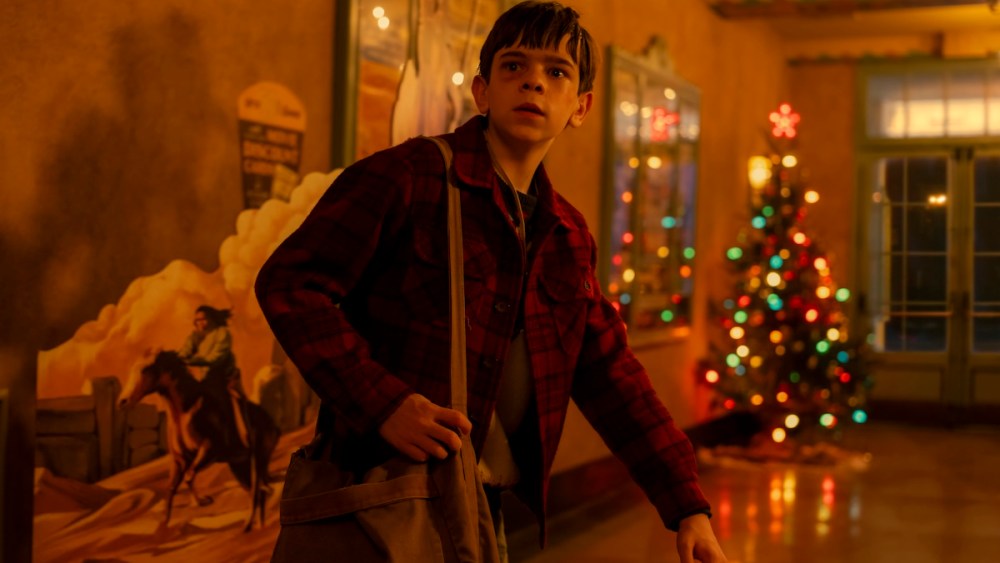Spoiler Alert: This story contains spoilers from the series premiere of “It: Welcome to Derry,” now streaming on HBO Max.
The first episode of “It: Welcome to Derry” will be the beginning of not just one season of television, but three upcoming seasons focused on the Maine town of the same name and the origins of its harrowing clown curse, series co-creators Andy and Barbara Muschietti tell Variety. “Our big story includes three seasons and is primarily based on the three important Pennywise cycles: 1962, 1935 and 1908,” says Andy.
As you can see in the first episode, Season 1 primarily takes place in 1962, 25 years before the events of “IT: Chapter 1.” A direct prequel to Andy Muschietti’s 2017 film, it explores a previous generation of children and adults in Derry as they battle and unravel the origins of the series’ antagonist, Pennywise the Clown (Bill Skarsgård).

Provided by Brooke Palmer/HBO
Muschietti’s two “It” films followed the main storyline of Stephen King’s 1986 novel, but “Welcome to Derry” explores the deeper lore hinted at throughout the novel. “I read the book and watched the interludes,” Andy says. “I realized that there was a hidden story there, and that Stephen King had left behind some detritus somewhere that could serve as a guide. This is a story told backwards.”
Although the Muschiettis have been reluctant to divulge details about the series’ long-term future, the book offers hints about what happened in Derry during Pennywise’s previous cycles. The town’s origins are strange, involving a celestial object that crashed into Derry and a sacred tortoise-like being named Maturin. Eagle-eyed viewers will recognize the moments when turtles appear on screen in the movies IT and Welcome to Derry. “Those are a lot of Easter eggs,” Andy says with a laugh. “And over the course of these three seasons, we’ll probably get closer to the meaning of the turtles and how they influence the characters’ actions and the mythological backstory.”

Provided by Brooke Palmer/HBO
Also featured in the book and further elaborated on in the show’s first episode is Derry’s dark history of racism. In the premiere, Major Leroy Hanlon (Jovan Adepo) arrives in predominantly white Derry and is immediately met with disrespect and racist attacks. The book also connects Pennywise’s origins with Derry’s original Native American tribes in a colonial allegory. “Stephen King is a writer who is very sensitive to social injustice. He talks about the evil of clowns, but mainly about the evil that we do to each other as humans. Most of the horrible things that happen in Derry are man-made,” says Andy.
This social commentary existed in the subtext of the movie “IT,” but it comes to the surface in the show. This emphasis reflects the cultural and political changes that have occurred since the film was released in 2017 and 2019. Barbara, who served as an executive producer on both films and the series, said: “Many of us are on high alert. There’s a heightened awareness and acceptance of all these issues because the dangers we thought were gone are back. This definitely hits home.”
However, the show’s intellectual horror in no way dilutes the gore on screen. The first episode, directed by Andy, features three special effects-heavy sequences of monster incarnations attacking children. The first scene comes in the show’s shockingly cold opening, in which a mother gives birth to a demonic baby, which then attacks an 11-year-old boy.

Provided by HBO
“It was very clear to Andy and I that we had to start the show with something very strong,” says Barbara.
“Because that’s how we set the tone of the movie, both in Georgie’s (Jackson Robert Scott) scenes and Adrian Mellon’s (Xavier Dolan) scenes. So we had to arrive at something very intense.”
The final scene of the episode is equally graphic and adds to the gruesome development. This episode introduces an ensemble of young characters that viewers assume will become the show’s main heroes. However, in the final scene, the mutant babies return and kill half of them in a brutal sequence. As Andy says, this twist conveys that “no one is safe in this world.”
“This is not a cliffhanger in the classic sense,” he continues. “There’s nothing left. You’re like, ‘Now what?'”

Brooke Palmer/HBO
“You can’t repeat a movie, so it was important to us to tell a very unpredictable story,” says Barbara. “We needed the kids, because without them, ‘it’ doesn’t exist. And we needed the kids to be friends and fight this monster together. But we needed to flip the story in some way.”
With seven more episodes airing Sunday nights on HBO and two more seasons planned, we’re sure to see more developments. Given the first episode’s deadly climax, the future of the story is vague and uncertain. One thing is for sure: no one is safe in Delhi.

